Aug 15, 2018
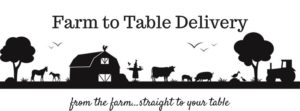 As part of a large, multi-stake Solano Local Food system project, Cultivate Community Food Co-op, in cooperation with other county organizations, will be working on a pilot project through September 21st with local farmers and chefs to offer participating co-op owners weekly home delivery of local, sustainably-grown produce and locally prepared meals. There will be no charge for home delivery for this pilot, though participants will need to pay for any food purchased.
As part of a large, multi-stake Solano Local Food system project, Cultivate Community Food Co-op, in cooperation with other county organizations, will be working on a pilot project through September 21st with local farmers and chefs to offer participating co-op owners weekly home delivery of local, sustainably-grown produce and locally prepared meals. There will be no charge for home delivery for this pilot, though participants will need to pay for any food purchased.
The purpose of this effort is to collect data in regards to the costs of labor, equipment and time that is needed to develop and implement a local food network that supports Solano County consumers, farmers, and chefs. The results obtained will be used to better understand the opportunities and challenges that exist to achieve the goal of building the community and economy while improving access to healthy, sustainably grown food.
Cultivate Community Food Co-op (CCFC) will be Solano County’s first community-owned, natural grocery store providing high-quality, locally-sourced, culturally-relevant, ethically- produced and affordable products.
Click here for information about how to become a member.
Mar 26, 2018
by: Kimberly K. Fu
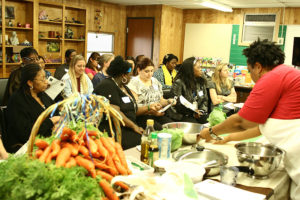
Image from www.sustainablefoodcenter.org
[Click here for The Reporter full article link]
Sustainable Solano is all about getting locally-grown food to local people.
Thanks to a grant from the United States Department of Agriculture (USDA), the nonprofit can move forward with the project.
On a recent day the group’s executive director, Elena Karoulina, and Stephanie Oelsligle Jordan, project manager and chef, shared insight into their ideas.
“We’ve been working on this for a long time,” Karoulina advised. “It’s a lot of work.”
The goal is to create access points, aka community food centers, where residents can pick up produce boxes from local farms, buy eggs and dairy and meat and other edibles and take cooking, nutrition and other classes.
In this way, Karoulina said, local farmers can sell their food, residents can buy them and learn how to prepare them and everyone gains better health.
It’s been a process, Jordan said, to locate all the farmers and others in Solano who might be a part in community food centers. As well, finding locations for those centers has been daunting.
But the 15-month Local Food Promotion Program planning grant from the USDA awarded in September at least provides necessary funding to get Sustainable Solano’s feet wet.
The group has partnered with researchers at the University of California, Davis; Solano County Department of Agriculture; and the Department of Public Health. On the agenda is a feasibility study, business plan and how to make a go of the food centers.
Engagement is a huge part of the project. To that end, Solano County Supervisors John Vasquez and Erin Hannigan have been instrumental in the project, Karoulina said, as have numerous other individuals and group.
Community talks are in the works.
Sought is input, lots and lots of input, on what people need and want and hope for. What locations would be great for a community center and is there a best time for such a facility to be open?
All thoughts will be taken under advisement, both women assured.
The study is set to be finalized this month.
The business plan and an outline of the implementation plan should be finalized by December.
Feb 26, 2018
by: Elena Karoulina, Executive Director
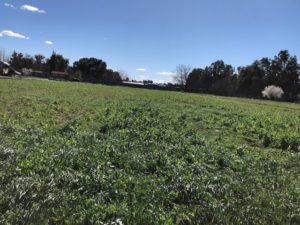
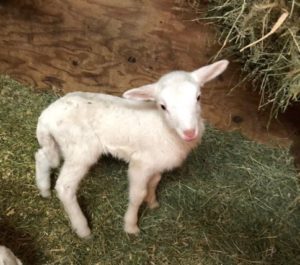
A couple weeks ago I had a great visit with Denise and Ben Lyons at their Lockewood Acres Farm in Vacaville. As a part of our work on the Solano Local Food System, I am getting to know local small farmers who are doing things right: they take care of the soil on their farms, plant diversified crop, pay special attention to the health of their water, strive for low-input farming (producing most of the fertility on the farm), and as a rule, look to work with nature, not against it, in harmonious, healing relationships with land, all living things and their communities.
Denise and Ben Lyons are this type of sustainable farmers. Their 10-acre beautiful, certified organic farm is located in the agricultural area between Vacaville and Dixon. When I came on a breezy & chilly February morning, both farmers were outside: Ben was fixing things around the barn, and Denise was wrapping up a meeting with Solano farmbudsman, Sarah Hawkins, going over rules and regulations governing various aspects of the farms’ operation. Even a small farm is a serious business, with its hard labor in the fields, barns and orchard, and different, but equally demanding work behind the scene: marketing, accounting, legal compliance, reporting… The work is endless and most of it is unseen by the community that gets to enjoy the fruits of this hard labor.
Most of the fields were resting for winter, covered by a green blanket of cover crop – fava beans, peas and other nitrogen-fixers. Before these plants go to seed, Ben will work this green manure into the fields, enriching and nurturing the soil, increasing its organic matter and improving water retention. This healthy soil will then feed the plants growing there that will eventually find their way to our kitchens and tables: tomatoes, cucumbers, eggplants, peppers, watermelons, salad greens, squashes, culinary herbs, and all sorts of root vegetables.
Fruit trees in the nearby orchard were also resting, waiting for the time when the sap will begin to flow, followed by beautiful fragrant flowers and then fruits. Apples, pears, all sorts of citrus, persimmons, plums, cherries, pomegranates, and figs – the list goes on and on of the bounty produced in this well-designed orchard. Olives are pressed in small batches in a local olive press – you can buy this olive oil directly from the farm.
Countless chickens were roaming the orchard, scratching the soil and adding natural fertilizers everywhere they went. Careful selection of heritage breeds provides for nutritious eggs in all possible colors: dark brown, light brown, blue, green, white.
In the small barns, there were dairy goats and hard-working sheep that regularly provide grass mowing services in the orchard, surrounded by adorable little ones constantly looking for milk and warmth. Keeping animals on the farm ensures a reliable source of manure, the traditional foundation of soil fertility, that decreases the demand for the outside input and supports this vibrant ecosystem called “Lockewood Acres Farm”.
An apiary completes the picture of the farm. Raw, delicious honey is available for sale year around.
Denise and Ben’ journey to this farm started with a discovery of the benefits of earthworms. Their original vision was to develop a homestead to nourish the immediate family. The vision eventually grew to include feeding the community! After the initial skepticism (mostly from Ben), the couple turned to organic farming, which Ben now describes as a “common-sense approach to farming”.
Would you like to join the community of the Lockewood Acres Farm well-nourished customers? This is what the Community Supported Agriculture stands for! Sign up to become a member of this farm’s CSA program. For more details, click here. If you are at the Vacaville Farmers Market on Saturdays, stop by the Lockewood Acres Farm stand and please say hi from their friends at Sustainable Solano!
There are multiple ways to participate and the farmers are flexible to work with you and your budget to provide nutrient dense, wholesome food for you and your family!
Feb 1, 2018
by Stephanie Oelsligle Jordan, Sustainable Solano, Local Food System Manager
This was my first EcoFarm conference. When initially sifting through the options for lectures and discussions about a month ago, I noticed the obvious: “how-to” workshops on various technicalities of farming, and peer discussions on what works (or doesn’t) in agriculture today, new inventions, pest management, etc. What I wasn’t expecting were some amazing and relevant discussions and speeches addressing how today’s farmers must intersect with larger social/world issues including hunger, social justice in food systems, honoring Native American lands, and climate change, just to name a few.
But there was another underlying, somewhat spiritual theme that seemed to arise from the workshops and discussions that I attended: our relationship to – and responsibility for – a given place, whether we farm it or not. It was this “sense of place” that I found myself thinking about the most, and how that idea might serve my work with Sustainable Solano’s Local Food initiatives.
I am not an expert in Permaculture or Biodynamic farming (I’m a chef!) but I gathered that this “sense of place” is vitally important in both methods of farming. In a talk titled “Nature Connection, Permaculture & Ecological Responsibility,” Will Scott of Sonoma’s Weaving Earth Center for Relational Education took us on a journey both inside our minds and hearts, and then – literally – out into the woods. His initial argument was that “our sense of awareness of our landscape and surroundings has been limited by the industrialized world….The mind has been colonized, and the story of separation has been ingrained….Modern experience has atrophied our ‘whole being sense.’” But all is not lost!
Through “Nature Connection,” we can regain our sense of connection. He made an interesting point (often forgotten, I might add) that our connection to the natural world just IS. We can’t deepen it. However, we can increase our capacity to interact with it and relate to it. “When love for a place happens,” he stated, “empathy is embodied and behavior can change to ensure the place is taken care of….If we want to start designing or thinking ‘whole system’, then we need to use our whole system too: heart and mind, and not just our intelligence.” He had a quote from someone else, which pretty much summed it up: “Lose your mind and come back to your senses!” So we did. He led us out to the woods, and for about 10 minutes we did nothing but let nature interact with our 5 senses, in what he called a “Sit Spot.”
Another workshop that touched upon this “sense of place” was a discussion group titled “Biodynamic Farming and Gardening for the Future”. Seasoned biodynamic farmers and newcomers to the method were sitting in a circle, and I was struck by one farmer who had previously farmed in Wisconsin. He had lately moved to California, and just wasn’t connecting to the land like he had in the Midwest. (This is a problem, by the way, if you want to be a biodynamic farmer!) As I learned about the importance of the farmer’s interaction with not only the land, but also the solar system, weather patterns, creatures big and small, and everything else in his/her “place,” I began to wonder about the rest of us. Is there a way to connect non-farmers to the land/place through the food?
This question also came up for me at a couple of workshops on Community Supported Agriculture (CSA) programs. As you’d guess, the CSA discussions were largely about how to acquire and retain subscriptions. After addressing the logistical issues (marketing, surveys, packaging, software, etc.), the group concluded that 1) education about CSAs was important and 2) people want a connection to local farmers. Here’s that connection theme again!
The final talk I attended was titled “The Farmer and the Chef: Utilizing Abundance” (Finally! Something I understand!) and featured exactly that: Farmer Jeff Dawson of The Farm in Woodside, CA and Chef Stuart Brioza of State Bird Provisions and The Progress restaurants in San Francisco. Here they were, presenting their collaboration, along with all the spreadsheets and systems that have made it work over the past 5 years. This is admittedly a very specialized relationship, in which the majority of us will not experience. However, Chef Brioza made a good point, which is not unlike the CSA programs, and has this idea of connection at heart: “You’re not just partnering with a farm. You’re partnering with abundance, and the harvest….We are telling a story about the farm, on the plate.”
I’m sure I left EcoFarm with more questions than answers. (How can the larger population become involved in that “sense of place” in order to appreciate the value of the farmer’s work? How can this “sense of place” influence our local farmers to take better care of their soil? How are we ALL responsible for this place, whether we farm it or not?) And I think most of the attendees may have left with more questions as well. However, I sensed an energy among all of us that in the midst of all the questions, we all had an unwritten and unspoken commitment to one another to move forward. Everyone seemed courageous….ready to make connections….and do what it takes to care for their respective places on the planet.
Made possible by Solano Public Health in partnership with the Yocha Dehe Wintun Nation
Nov 30, 2017
Starting this past October, Veronica Bearce, Susan Neuhaus, and Annette Batchelor have been managing the Community Supported Agriculture (CSA) program in Benicia. If you pick up farm-fresh food on Wednesdays at Heritage Presbyterian Church, say THANK YOU to these amazing women! Their commitment of time and energy has made it easier for folks in Benicia to get high-quality products from surrounding farms and fisheries. Sustainable Solano is very grateful for their involvement in this project.
if you would like to implement a similar program in your town, contact Stephanie Jordan, our Local Food Program Manager at stephanie@sustainablesolano.org
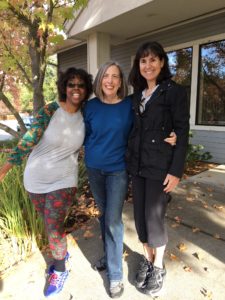
Nov 1, 2017
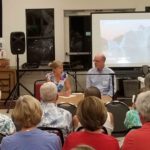
By Stephanie Oeslgigie Jordan, Project Manager, Chef
Can a community decide how it will access food for its members? Is there democratic participation in our food system? What mindsets frame the future of our local food systems? These questions and more kicked off a fascinating lecture-discussion led by Dr. Gail Feenstra and Dr. David Campbell of UC Davis on October 25. Coordinated by Sustainable Solano, the talk was part of an ongoing program hosted by Heritage Presbyterian Church in Benicia, titled “How to Make the World a Better Place,” which features presentations and learning opportunities for people of all ages in Benicia.
Structured as an interview akin to Terry Gross’ “Fresh Air” program on NPR, Drs. Feenstra and Campbell asked provocative questions to each other, to get at the heart of issues surrounding local food systems. The idea of “Local Food” has grown exponentially in the last couple of decades. Dr. Campbell pointed out that in 1997, he and his research team could find only 100 articles on local food, and in 2011 there were over 2000 articles! (In fact, the USDA LFPP grant that Sustainable Solano was awarded didn’t exist 10 years ago.) So, what is all the fuss about? Communities are becoming increasingly interested in how food will be produced, distributed and sold. Over the years, competitive grants programs began to pop up (i.e. Placer Grown, Solano Grown) along with other programs that help communities start businesses and projects that assist local farmers/growers.
When running a food project, Dr. Feenstra had 3 important tips for success (she called them the “3 Ps”): 1) Partnerships are key, and the more diverse your partnerships, the better; 2) Public Participation is necessary for a solid community base and the development of leaders; and 3) maintaining high Principles & Values will help projects achieve social and environmental justice.
Sounds easy, right? Well….there are some challenges according to Dr. Campbell, when asked about planning future food systems. There are 3 different frames of mind out there, each with a different focus. The first is driven by the question, “How are we going to feed 9 billion people?” This perspective is driven by the idea that we need “more”, and incorporates the latest farming technology to increase volume and production. The second group has an environmental focus, driven by climate change. A local example includes the fact that crops are changing location in California, due to increased heat, drought, and changing weather patterns. (We might add that sustainable vs. unsustainable farming methods would affect this problem as well.) The third group is focused on social justice, asking “Why doesn’t everyone have access to healthy food?” and “Who is really running the elements of our food system?”
Not surprisingly, the solution lies in the need for these 3 frames to work together, instead of compete for attention. But how? Dr. Campbell suggests that local communities have advantages of doing work that integrates these elements. Referencing Daniel Kemmis’ book, Community and the Politics of Place, Dr. Campbell theorizes that it is this common love of place that can serve as a foundation to bring people together and allow communities to better tackle issues and develop their own systems. At the same time, communities must have peripheral vision – they must learn to see what’s around them, and develop diverse partnerships with people who can contribute their own unique experiences. If you are too local, you will fight the symptoms, but not the root cause.
And remember those 2000 articles that now exist on local food systems? All that research has illuminated three challenges, which communities must keep in mind: 1) Economic challenges which dance between paying the farmer enough money (so that he/she can continue farming), yet making food affordable for everyone, 2) Social challenges, addressed by numerous studies showing how middle- and upper-class white people are the only ones who can afford healthy food, and 3) Political challenges which highlight the lack of cooperation between one side of the food movement which wants to make changes within, and the other side which wants to “blow up” the system and start something entirely new.
In spite of all these challenges, Dr. Campbell subscribes to what he calls “hopeful realism.” The talk finished with a video of a UC Davis urban agriculture project, where youth work at a community garden in Oakland. Instead of having the director of the program lead a tour through the garden, UC Davis asked the youth to talk about their experiences and knowledge while the camera rolled. At the end of the video, teens and youth were using words such as “love” and “happy” to describe how they felt about their work in the garden. When diverse groups of participants come together and cooperate to solve issues, everyone has the opportunity to benefit in some way.
About the speakers:
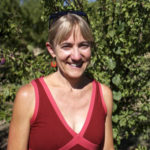 Gail Feenstra is the Deputy Director of the Sustainable Agriculture Research and Education Program (SAREP), a program of the Agricultural Sustainability Institute at UC Davis and the UC Division of Agriculture and Natural Resources (ANR). For Dr. Feenstra’s full biography, click here.
Gail Feenstra is the Deputy Director of the Sustainable Agriculture Research and Education Program (SAREP), a program of the Agricultural Sustainability Institute at UC Davis and the UC Division of Agriculture and Natural Resources (ANR). For Dr. Feenstra’s full biography, click here.
http://asi.ucdavis.edu/people/Feenstra
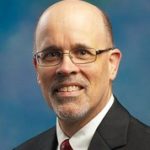 David Campbell, a political scientist, is Associate Dean for social/human sciences in the College of Agricultural and Environmental Sciences at UC Davis. He was appointed Associate Dean in October 2014. For Dr. Campbell’s full biography, click here.
David Campbell, a political scientist, is Associate Dean for social/human sciences in the College of Agricultural and Environmental Sciences at UC Davis. He was appointed Associate Dean in October 2014. For Dr. Campbell’s full biography, click here.
http://www.caes.ucdavis.edu/about/directory/fsd/david-campbell
 As part of a large, multi-stake Solano Local Food system project, Cultivate Community Food Co-op, in cooperation with other county organizations, will be working on a pilot project through September 21st with local farmers and chefs to offer participating co-op owners weekly home delivery of local, sustainably-grown produce and locally prepared meals. There will be no charge for home delivery for this pilot, though participants will need to pay for any food purchased.
As part of a large, multi-stake Solano Local Food system project, Cultivate Community Food Co-op, in cooperation with other county organizations, will be working on a pilot project through September 21st with local farmers and chefs to offer participating co-op owners weekly home delivery of local, sustainably-grown produce and locally prepared meals. There will be no charge for home delivery for this pilot, though participants will need to pay for any food purchased.





 Gail Feenstra is the Deputy Director of the Sustainable Agriculture Research and Education Program (SAREP), a program of the Agricultural Sustainability Institute at UC Davis and the UC Division of Agriculture and Natural Resources (ANR). For Dr. Feenstra’s full biography, click here.
Gail Feenstra is the Deputy Director of the Sustainable Agriculture Research and Education Program (SAREP), a program of the Agricultural Sustainability Institute at UC Davis and the UC Division of Agriculture and Natural Resources (ANR). For Dr. Feenstra’s full biography, click here. David Campbell, a political scientist, is Associate Dean for social/human sciences in the College of Agricultural and Environmental Sciences at UC Davis. He was appointed Associate Dean in October 2014. For Dr. Campbell’s full biography, click here.
David Campbell, a political scientist, is Associate Dean for social/human sciences in the College of Agricultural and Environmental Sciences at UC Davis. He was appointed Associate Dean in October 2014. For Dr. Campbell’s full biography, click here.